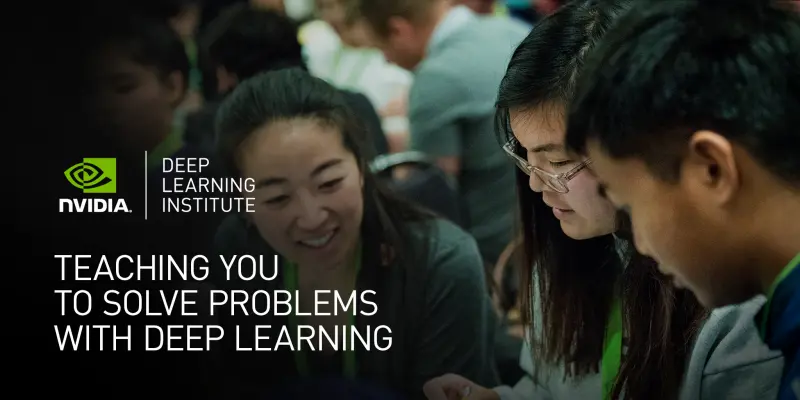
NVIDIA DLI courses at the University of Debrecen
The NVIDIA Deep Learning Institute (DLI) offers resources for diverse needs - from learning materials to self-paced and live training to educator programs - giving individuals, teams, organizations, educators, and students what they need to advance their knowledge in AI, accelerated computing, data science, graphics and simulation, networking, and more. With access to GPU-accelerated servers in the cloud, you’ll learn how to train, optimize, and deploy neural networks using the latest deep learning tools, frameworks, and SDKs. You’ll also learn how to assess, parallelize, optimize, and deploy GPU-accelerated computing applications.
INSTRUCTOR-LED WORKSHOPS
DLI workshops teach you how to implement and deploy an end-to-end project in one day. These in-depth classes are taught by experts in their respective fields, delivering industry-leading technical knowledge to drive breakthrough results for individuals and organizations. Participants can earn a certificate of competency to support their long-term professional growth. Workshops are currently delivered remotely via a virtual classroom. In-person training will be offered as conditions permit. Public workshops are scheduled year-round and are available for single-seat registrations. visit the DLI website for the current schedule. Private workshops are available for organizations. Contact DLI at nvdli@nvidia.com for more details.
Upcoming workshops:
Locations of interested persons/participants so far:
Our instructors:
| László Kovács Ph.D. - Assistant Professor | |
|---|---|
 |
|
| András Hajdu Ph.D. - Full Professor | |
|---|---|
 |
|
| Gergő Bogacsovics - PhD Student | |
|---|---|
 |
|
ONLINE COURSES
Online, self-paced courses show you how to set up an end-to-end project in eight hours or how to apply a specific technology or development technique in two hours. online courses can be taken anytime, anywhere - as long as you have a computer (desktop or laptop) and an internet connection. Several courses offer a certificate of competency upon completion of the built-in assessment. Explore one-click notebooks and get free hands-on experience in deep learning, accelerated computing, and data science. The courses, ranging from as little as 10 minutes to 60 minutes, help expose you to the fundamental skills you need to do your life’s work.
Available courses
INSTRUCTOR-LED WORKSHOPS
DEEP LEARNING FUNDAMENTALS
Fundamentals of Deep Learning
Learn how deep learning (DL) works through hands-on exercises in computer vision and natural language processing (NLP). You will train deep learning models from scratch, and pick up tricks and tools for achieving highly accurate results along the way. You’ll also learn to leverage freely available, state-of-the-art pre-trained models to save time and get your deep learning application up and running quickly.
PREREQUISITES: An understanding of fundamental programming concepts in Python 3, such as functions, loops, dictionaries, and arrays. Also, familiarity with pandas data structures and an understanding of how to compute a regression line.
Learn more: LINK
Building Transformer-Based Natural Language Processing
Learn how to use Transformer-based natural language processing models for text classification tasks, such as categorizing documents. You will also get insight on how to leverage Transformer-based models for named-entity recognition (NER) tasks and analyze various model features, constraints, and characteristics to determine which model is best suited for a particular use case-based on metrics, domain specificity, and available resources.
PREREQUISITES: Experience with Python coding and use of library functions and parameters. Fundamental understanding of a deep learning framework such as TensorFlow, PyTorch, or Keras. And basic understanding of neural networks.
Learn more: LINK
Building Conversational AI Applications
Learn how to quickly build and deploy production quality conversational AI applications with real-time transcription and natural language processing capabilities.
PREREQUISITES: Experience with Python coding and use of library functions and parameters; fundamental understanding of a deep learning framework such as TensorFlow, PyTorch, or Keras; and basic understanding of neural networks
Learn more: LINK
Building Intelligent Recommender Systems
Explore the fundamental tools and techniques for building highly effective recommender systems, as well as how to deploy GPU-accelerated solutions for real-time recommendations.
PREREQUISITES: Intermediate knowledge of Python, including understanding of list comprehension. Data science experience using Python and familiarity with NumPy and matrix mathematics.
Learn more: LINK
Fundamentals of Deep Learning for Multi-GPUs
Find out how to use multiple GPUs to train neural networks and effectively parallelize training of deep neural networks using TensorFlow.
PREREQUISITES: Experience with stochastic-gradient-descent mechanics, network architecture, and parallel computing
Learn more: LINK
DEEP LEARNING BY INDUSTRY
Deep Learning for Industrial Inspection
Find out how to design, train, test, and deploy building blocks of a hardware-accelerated industrial inspection pipeline.
PREREQUISITES: Familiarity with deep neural networks and experience with Python and deep learning frameworks, such as TensorFlow, Keras, and PyTorch
Learn more: LINK
Deep Learning for Intelligent Video Analytics
Explore how to deploy object detection and tracking networks to evaluate real-time, large-scale video streams.
PREREQUISITES: Experience with deep networks (specifically variations of CNNs) and intermediate-level experience with C++ and Python
Learn more: LINK
Applications of AI for Anomaly Detection
Learn to detect anomalies in large datasets to identify network intrusions using supervised and unsupervised machine learning techniques, such as accelerated XGBoost, autoencoders, and generative adversarial networks (GANs).
PREREQUISITES: Experience with CNNs and Python
Learn more: LINK
Applications of AI for Predictive Maintenance
Discover how to identify anomalies and failures in time-series data, estimate the remaining useful life of the corresponding parts, and use this information to map anomalies to failure conditions.
PREREQUISITES: Experience with Python and deep networks
Learn more: LINK
ACCELERATED COMPUTING
Fundamentals of Accelerated Computing with CUDA® C/C++
Learn how to accelerate and optimize existing C/C++ CPU-only applications to leverage the power of GPUs using the most essential CUDA techniques and the NvIDIA NsightTM Systems profiler.
PREREQUISITES: Basic C/C++ competency, including familiarity with variable types, loops, conditional statements, functions, and array manipulations. No previous knowledge of CUDA programming is assumed.
Learn more: LINK
Fundamentals of Accelerated Computing with CUDA Python
Explore how to use Numba—the just-in-time, type-specializing Python function compiler—to accelerate Python programs to run on massively parallel NvIDIA GPUs.
PREREQUISITES: Basic Python competency, including familiarity with variable types, loops, conditional statements, functions, and array manipulations. Also, must have NumPy competancy, including the use of ndarrays and ufuncs.
Learn more: LINK
Accelerating CUDA C++ Applications with Multiple GPUs
Learn how to write CUDA C++ applications that efficiently and correctly utilize all available GPUs in a single node, dramatically improving the performance of applications and making the most cost-effective use of systems with multiple GPUs.
PREREQUISITES: Professional experience programming CUDA C/C++ applications, including the use of the NvIDIA CUDA Compiler (NvCC), kernel launches, grid-stride loops, host-to-device and device-to-host memory transfers, and CUDA error handling. Familiarity with the Linux command line and experience using makefiles to compile C/C++ code.
Learn more: LINK
Scaling CUDA C++ Applications to Multiple Nodes
Learn the tools and techniques needed to write CUDA C++ applications that can scale efficiently to clusters of NvIDIA GPUs.
PREREQUISITES: Intermediate experience writing CUDA C/C++ applications
Learn more: LINK
Fundamentals of Accelerated Computing with OpenACC
Learn how to write and configure code parallelization with openACC, optimize memory movements between the CPU and GPU accelerator, and apply the techniques to accelerate a CPU-only Laplace Heat Equation to achieve performance gains.
PREREQUISITES: Basic C/C++ or Fortran competency, including familiarity with variable types, loops, conditional statements, functions, and array manipulations. No previous knowledge of GPU programming is assumed.
Learn more: LINK
ACCELERATED DATA SCIENCE
Accelerating Data Engineering Pipelines
Learn how to employ advanced data engineering tools and techniques with GPUs to significantly improve data engineering pipelines.
PREREQUISITES: Intermediate knowledge of Python (list comprehension, objects); familiarity with pandas a plus; introductory statistics (mean, median, mode)
Learn more: LINK
Fundamentals of Accelerated Data Science
Learn how to perform multiple analysis tasks on large data sets using RAPIDS, a collection of data science libraries that allows end-to-end GPU acceleration for data science workflows.
PREREQUISITES: Professional data science experience with Python, including proficiency in pandas and NumPy. Also, must have familiarity with common machine learning algorithms, including XGBoost, linear regression, DBSCAN, K-Means, and SSSP.
Learn more: LINK
NETWORKING
The NVIDIA Networking Academy offers customizable training and certification on dozens
of networking topics, including InfiniBand, NvIDIA Cumulus LinuxTM, protocols configuration such as virtual Extensible LAN (vXLAN), Multi-Chassis Link Aggregation (MLAG), Border Gateway Protocol Ethernet vPN (BGP EvPN), and much more. The training combines hands- on practice and theoretical concepts to match job requirements and prepare participants for immediate productivity.
To explore what’s available, visit academy.mellanox.com
ONLINE, SELF-PACED COURSES
DEEP LEARNING FUNDAMENTALS
Building a Brain in 10 Minutes
This one-click notebook explores the biological and psychological inspirations for the world’s first neural networks.
Learn more: LINK
Getting Started with Deep Learning
Explore the fundamentals of deep learning by training neural networks and using results to improve performance and capabilities.
PREREQUISITES: An understanding of fundamental programming concepts in Python 3, such as functions, loops, dictionaries, and arrays; familiarity with pandas data structures; and an understanding of how to compute a regression line
Learn more: LINK
Getting Started with AI on Jetson Nano
Discover how to build a deep learning classification project with computer vision models using the NvIDIA Jetson NanoTM Developer Kit.
PREREQUISITES: Basic familiarity with Python (helpful, not required)
Learn more: LINK
Optimization and Deployment of TensorFlow Models with TensorRT
Learn how to optimize TensorFlow models to generate fast inference engines in the deployment stage.
PREREQUISITES: Experience with TensorFlow and Python TOOLS, LIBRARIES, FRAMEWORKS: TensorFlow,
Learn more: LINK
Deep Learning at Scale with Horovod
Find out how to scale deep learning training to multiple GPUs with Horovod, the open-source distributed training framework originally built by Uber.
PREREQUISITES: Competency in Python and professional experience training deep learning models in Python
Learn more: LINK
Getting Started with Image Segmentation
Learn how to categorize segments of an image.
PREREQUISITES: Basic experience training neural networks TOOLS, LIBRARIES, FRAMEWORKS: TensorFlow 2 with
Learn More. LINK
Modeling Time-Series Data with Recurrent Neural Networks in Keras
Explore how to classify and forecast time-series data using recurrent neural networks (RNNs), such as modeling a patient’s health over time.
PREREQUISITES: Basic experience with deep learning
Learn more: LINK
DEEP LEARNING BY INDUSTRY
AUTONOMOUS VEHICLES
Integrating Sensors with NVIDIA DRIVE®
Learn how to integrate automotive sensors into your applications using NVIDIA DRIvE.
PREREQUISITES: Basic experience in C++ and Linux terminal commands
Learn more: LINK
HEALTHCARE
Medical Image Classification Using the MedNIST Data Set
Explore an introduction to deep learning for radiology and medical imaging by applying CNNs to classify images in a medical imaging data set.
PREREQUISITES: Basic experience in Python
Learn more: LINK
Image Classification with TensorFlow: Radiomics—1p19q Chromosome Status Classification
Learn how to train CNNs to detect radiomics from MRI imaging.
PREREQUISITES: Basic experience with CNNs and Python
Learn more: LINK
Data Augmentation and Segmentation with Generative Networks for Medical Imaging
Discover how to use GANs for medical imaging by applying them to the creation and segmentation of brain MRIs.
PREREQUISITES: Experience with CNNs
Learn more: LINK
Coarse-to-Fine Contextual Memory for Medical Imaging
Find out how to use coarse-to-fine context memory (CFCM) to improve traditional architectures for medical image segmentation and classification tasks.
PREREQUISITES: Experience with CNNs and long short-term memory (LSTM)
Learn more: LINK
INTELLIGENT VIDEO ANALYTICS
AI Workflows for Intelligent Video Analytics with DeepStream
Learn how to build hardware-accelerated applications for intelligent video analytics (IvA) with DeepStream and deploy them at scale to transform video streams into insights.
PREREQUISITES: Experience with C++ and Gstreamer
Learn more: LINK
Getting Started with DeepStream for Video Analytics on Jetson Nano
Explore how to build DeepStream applications to annotate video streams using object detection and classification networks.
PREREQUISITES: Basic familiarity with C
Learn more: LINK
ACCELERATED COMPUTING FUNDAMENTALS
An Even Easier Introduction to CUDA
Learn the basics of writing parallel CUDA kernels to run on NvIDIA GPUs.
PREREQUISITES: Competency writing applications in CUDA C/C++
Learn more: LINK
Fundamentals of Accelerated Computing with CUDA C/C++
Discover how to accelerate and optimize existing C/C++ CPU-only applications to leverage the power of GPUs using the most essential CUDA techniques and the Nsight Systems profiler.
PREREQUISITES: Basic C/C++ competency, including familiarity with variable types, loops, conditional statements, functions, and array manipulations. No previous knowledge of CUDA programming is assumed.
Learn more: LINK
Fundamentals of Accelerated Computing with CUDA Python
Explore how to use Numba—the just-in-time, type-specializing Python function compiler—to create and launch CUDA kernels to accelerate Python programs on massively parallel NvIDIA GPUs.
PREREQUISITES: Basic Python competency, including familiarity with variable types, loops, conditional statements, functions, and array manipulations. Also, must have NumPy competency, including the use of ndarrays and ufuncs.
Learn more: LINK
Scaling Workloads Across Multiple GPUs with CUDA C++
Learn how to build robust and efficient CUDA C++ applications that can leverage all available GPUs on a single node.
PREREQUISITES: Competency writing applications in CUDA C/C++
Learn more: LINK
Accelerating CUDA C++ Applications with Concurrent Streams
Learn how to improve performance for your CUDA C/C++ applications by overlapping memory transfers to and from the GPU with computations on the GPU.
PREREQUISITES: Competency writing applications in CUDA C/C++
Learn more: LINK
Fundamentals of Accelerated Computing with OpenACC
Find out how to build and optimize accelerated heterogeneous applications on multiple GPU clusters using a combination of openACC®, CUDA-aware MPI, and NvIDIA profiling tools.
PREREQUISITES: Basic experience with C/C++
Learn more: LINK
High-Performance Computing with Containers
Learn how to reduce complexity and improve portability and efficiency of your code by using a containerized environment for high performance computing (HPC) application development.
PREREQUISITES: Proficiency programming in C/C++ and professional experience working on HPC applications
Learn more: LINK
ACCELERATED DATA SCIENCE
Speed Up DataFrame Operations With RAPIDS cuDF
This one-click notebook demonstrates significant speed up by moving common DataFrame operations to the GPU with minimal changes to existing code.
Learn more: LINK
Accelerating End-to-End Data Science Workflows
Learn how to perform multiple analysis tasks on large data sets using RAPIDS, a collection of data science libraries that allows end-to-end GPU acceleration for data science workflows.
PREREQUISITES: Experience with Python, ideally including pandas and NumPy
Learn more: LINK
GRAPHICS AND SIMULATION
Getting Started with USD for Collaborative 3D Workflows
Learn how to generate a scene using human-readable Universal Scene Description ASCII (.USDA) files. Upon completion, participants will be able to create their own scenes within the USD framework and will have a strong foundation to use it in applications such as NVIDIA OmniverseTM, Maya, Unity, and Unreal Engine.
PREREQUISITES: A basic understanding of computer graphics concepts such as vertices, meshes, and RGB values and an understanding of fundamental programming concepts in Python such as functions, loops, dictionaries, and arrays.
Learn more: LINK
GPU COMPUTING IN THE DATA CENTER
Introduction to AI in the Data Center (Digital Badge Available)
Explore AI, GPU computing, NvIDIA AI software architectures, and how to implement and scale AI workloads in the enterprise data center.
PREREQUISITES: Basic knowledge of enterprise networking, storage, and data center operations TOOLS, LIBRARIES, FRAMEWORKS: Artificial intelligence, LANGUAGE: English
Learn more: LINK
NETWORKING
The NvIDIA Networking Academy offers dozens of online, self-paced courses and certifications on networking topics such as InfiniBand, remote direct-memory access (RDMA) programming, Cumulus Linux, data center protocols configuration, network automation tools, and much more.
To explore the offerings, visit academy.mellanox.com
Enquire

If you are interested in any of the NVIDIA DEEP LEARNING INSTITUTE courses please contact us here: LINK